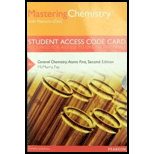
Concept explainers
(a)
Interpretation:
The value of x in iron oxide
(b)
Interpretation:
The average oxidation state of iron has to be calculated.
(c)
Interpretation:
The percentage of
Concept introduction:
Wustite:
Wustite is iron oxide with empirical formula of
(d)
Interpretation:
The angle at which atoms meet in face centered cubic unit cell has to be calculated.
Concept introduction:
Braggs law:
Where,
n is order of diffraction.
d is lattice spacing
(e)
Interpretation:
The doping of
Concept introduction:
Semiconductor: A material which can conduct electricity in range between a metal and an insulator is known as semiconductor. Addition of small amount of impurities increases conductivity of semiconductor and the process is known as doping. n-type and p-type are two types of doped semiconductors.
n-type: This is a type of doped semiconductor in which many free electrons are present in conduction band.
p-type: This is a type of doped semiconductor in which holes are present in valence band.
Want to see the full answer?
Check out a sample textbook solution
Chapter 21 Solutions
Masteringchemistry with Pearson Etext -- Standalone Access Code Card -- For General Chemistry
- (a) Determine the number of calcium ions in the chemicalformula of the mineral hardystonite, CaxZn(Si2O7). (b)Determine the number of hydroxide ions in the chemicalformula of the mineral pyrophyllite, Al2(Si2O5)2(OH)x.arrow_forward(1) Diamond and graphite are two minerals with identical chemical compositions, pure carbon (C). Diamond is the hardest of all minerals, and graphite is one of the softest. If their compositions are identical, why do they have such profound differences in physical properties? (2) silicon and oxygen together make up nearly 75 percent by weight of the Earth's crust. But silicate minerals make up more than 95 percent of the crust. Explain the apparent discrepancy. (3) If you were given a crystal of diamond and another of quartz, how would you tell which is diamond? (4) Would you expect minerais found on the Moon, Mars, or Venus to be different from those of the Earth's crust? Explain your answer. (5) Quartz is Si02. Why does no mineral exist with the composition Si03?arrow_forward(c) Calculate the atomic radius of Chromium (Cr), given that it has a body-centred cubic (BCC) crystal structure and a density of 7.19 g/cm.arrow_forward
- An ideal quantum dot for use in TVs does not contain anycadmium due to concerns about disposal. One potentialmaterial for this purpose is InP, which adopts the zinc blende (ZnS) structure (face-centered cubic). The unit celledge length is 5.869 Å. (a) If the quantum dot is shaped likea cube, how many of each type of atom are there in a cubiccrystal with an edge length of 3.00 nm? 5.00 nm? (b) Ifone of the nanoparticles in part (a) emits blue light and theother emits orange light, which color is emitted by the crystalwith the 3.00-nm edge length? With the 5.00-nm edgelength?arrow_forwardThe gap between valence and conduction bands in diamond is 5.47 eV. (a) What is the maximum wavelength of a photon that can excite an electron from the top of the valence band into the conduction band? In what region of the electromagnetic spectrum does this photon lie? (b) Explain why pure diamond is transparent and colorless.arrow_forwardThe maximum wavelength of light that a certain silicon photocell can detect is 1.11 μm. (a) What is the energy gap (in electron volts) between the valence and conduction bands for this photocell? (b) Explain why pure silicon is opaque.arrow_forward
- (a) A hypothetical compound MB2 crystallises in the rutile lattice structure. (i) Draw the lattice structure of the unit cell MB2. (ii) Show by calculation that the stoichiometry of the formula is consistent with the structure. (iii) Determine the coordination number of the MB₂ unit cell.arrow_forwardBy making use of CFT in tetrahedral and octahedral geometries, predict whether nickel ferrite mineral (NiFe2O4) has a normal spinel or inverse spinel structure. Explain the structure of this mineral in detail.arrow_forwardIron titanate, FeTiO3, forms in the ilmenite crystal structure that consists of an HCP arrangement of O2- ions. (a) Which type of interstitial site will the Fe2+ ions occupy? (b) Which type of interstitial site will the Ti4+ ions occupy? (c) What fraction of the total tetrahedral sites will be occupied? (In decimal form to two places to the right of the decimal) (d) What fraction of the total octahedral sites will be occupied? (In decimal form to two places to the right of the decimal)arrow_forward
- Predict the structure of each of the following silicate minerals (network, sheets, double chains, and so forth). Give the oxidation state of each atom.(a) Apophyllite, KCa4(Si8O20)F ? 8 H2O(b) Rhodonite, CaMn4(Si5O15)(c) Margarite, CaAl2(Al2Si2O10)(OH)2arrow_forwardA particular form of cinnabar (HgS) adopts the zinc blendestructure. The length of the unit cell edge is 5.852 Å.(a) Calculate the density of HgS in this form. (b) The mineraltiemannite (HgSe) also forms a solid phase with the zincblende structure. The length of the unit cell edge in thismineral is 6.085 Å. What accounts for the larger unit celllength in tiemmanite? (c) Which of the two substances hasthe higher density? How do you account for the differencein densities?arrow_forwardWhat is the minimum number of atoms that could be containedin the unit cell of an element with a face-centered cubiclattice? (a) 1, (b) 2, (c) 3, (d) 4, (e) 5.arrow_forward
 Chemistry: The Molecular ScienceChemistryISBN:9781285199047Author:John W. Moore, Conrad L. StanitskiPublisher:Cengage Learning
Chemistry: The Molecular ScienceChemistryISBN:9781285199047Author:John W. Moore, Conrad L. StanitskiPublisher:Cengage Learning Principles of Modern ChemistryChemistryISBN:9781305079113Author:David W. Oxtoby, H. Pat Gillis, Laurie J. ButlerPublisher:Cengage Learning
Principles of Modern ChemistryChemistryISBN:9781305079113Author:David W. Oxtoby, H. Pat Gillis, Laurie J. ButlerPublisher:Cengage Learning

